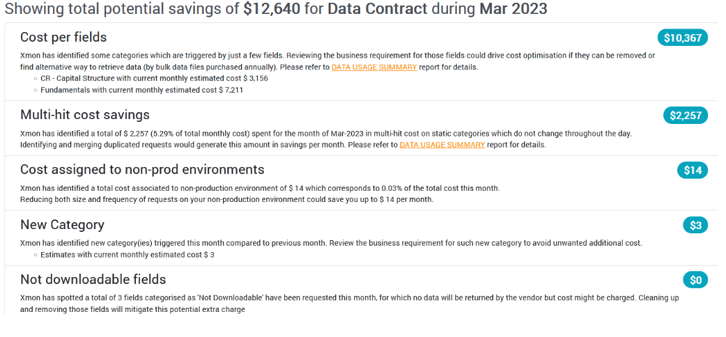Introducing Xmon's new Cost Optimization feature
This brand-new Cost Optimization feature within Xmon instantly analyzes your usage and spend to provide automated optimization recommendations.
It scans your consumption and provides an automatic and intelligent summary of actionable insights, along with expected savings 💲
Automatic summary analysis of all recommendations will display for the current month - highlighting total potential savings. These are then broken down and summarized by sections in a clear and easy to understand manner and starting with the biggest potential savings first.
If you're already an Xmon users, to access this feature, simply navigate to the reports menu and select Cost Optimization:

Amongst other recommendations, Cost per fields section helps you identify categories triggered by just a few fields, adding great value to optimization discussion in your enterprise. Additionally, clicking on the data usage summary hyperlink will take you to the existing page with additional detailed analysis at field and request level, helping to drive your costs down further.
Multi-Hit cost optimization, shows potential savings for static categories and inefficient data requests, as well as automated percentage allocation of non-production related data request costs.
Reduce your Reference Data Costs by 10-15% by Utilizing Field Level Analysis🚀
Users utilize Xmon with field level analysis to optimize their costs further.
When downloading reference data from third party vendors you will be charged for each billable category, which you are requesting. A billable category is charged as soon as a single field from that category is requested.
It is therefore crucial to know what is requested in your organization across all systems and environments at a field level.
Such a granularity could be challenging and time consuming to report month after month, unless you are equipped with a “smart meter” for reference data, such as Xmon 💡
Xmon empowers data management teams to identify expensive categories, which are triggered by just a few fields, as well as challenge the business to review the necessity of retrieving this data. Xmon clients were able to reduce their overall reference data cost between 10-15% on multiple separate occasions, by only turning off fields that were no longer used in downstream systems 💲
If the data is required by the business, the review is usually followed by validating the scope for those fields by asset type, as indeed not all fields may be needed across all asset types. The approach of “one-size-fits-all” is quick to implement but more expensive to run, resulting in spiraling and uncontrolled spend.
In one client use cases, Xmon guided a large asset manager to split data acquisition requests by asset type and only select fields relevant to each asset class, generating a cost saving of around 22%.
Managing Reference Data Flowing Within the Organization
Managing reference data with confidence has become increasingly important in today’s data-driven business environment. It is important to track reference data coming from external sources, i.e. data vendors, into the organization, as well as tracking data moving between systems within the organization.
However, tracking reference data inside an organization can be a daunting task, especially when it involves multiple systems and data sources formats and mappings.
This is where Xmon can help 💡 (Also check our blog: Mastering Reference Data Management: Tips for Success)
1. Customizable Mappings for Securities and Data Attributes
One of the key features of Xmon is its customizable mappings for securities and data attributes. This feature enables firms to map their own internal security references and data attributes, ensuring that their data is accurately represented, classified, and organized. This feature allows tracking reference data points within the organization, even if they are modified or mapped on their journey from source to consumer.
2. Customizable Cost Models
Xmon also includes customizable cost models. This feature enables businesses that wish to do so, to track the costs associated with their reference data as it flows within the organization, allowing them to monetize and allocate spend internally in a fair and transparent way.
3. Customizable Data Formats
Whether data is distributed on queues, in files or other formats such as JSON or XML, Xmon provides integration adapters that allows the ingestion of data requests in their native formats for tracking within the organization.
The Importance of Tracking Reference Data within the Organization
✅ Transparency of Usage and Accountability
Tracking reference data inside an organization is important for several reasons. Firstly, it promotes transparency of usage and accountability. By tracking reference data, businesses can have a better understanding of who is using what type of data in the organization and enable transparency of spend and reporting. This promotes accountability and ensures that reference data is being used effectively and in the most cost efficient way possible.
✅ Data Lineage
Secondly, tracking reference data enables data lineage. Data lineage is important because it enables businesses to trace the origin and transformation of their reference data. With data lineage, businesses can ensure that their reference data is accurate and reliable, and that it meets the specific needs of their business.
✅ Internal Cost Allocation
Finally, tracking reference data enables internal cost allocation. By tracking reference data, businesses can ensure that their data management costs are allocated appropriately across their organization. This ensures that data management costs are optimized, and that reference data is managed in a cost-effective manner.
Client Use Case: A larger Asset Management Firm
A global asset management firm had been using Xmon to track data requests from their central Enterprise Data Management (EDM) system to external vendors for several months, reducing costs and improving transparency. Following the successful deployment on the external side, the client then moved on to leverage Xmon internally to track reference data between the EDM system and ultimate internal consumer.
By using Xmon’s flexible data mapping and realtime tracking functionality, the client optimized spend by identifying data points that were acquired but never used, removing them from vendor calls and started allocated costs fairly to internal data consumers based on actual usage. This resulted in improved transparency, better usage reporting for compliance and audit purposes and a further cost reduction of 8% on overall data spend.
Xmon empowered this client to track reference data effectively both internally and externally, leading to decreased costs, enhanced transparency, and fairer cost allocation.
📽️ Watch Presentation
At the DKF 2023 conference at the beginning of May in Munich, Amjad Zoghbi, director at Xpansion gave an interesting presentation on 'Managing market data with confidence: The role of Reference Data Management' - give it a watch 👇
Looking for help understanding and optimizing your reference data spend?





